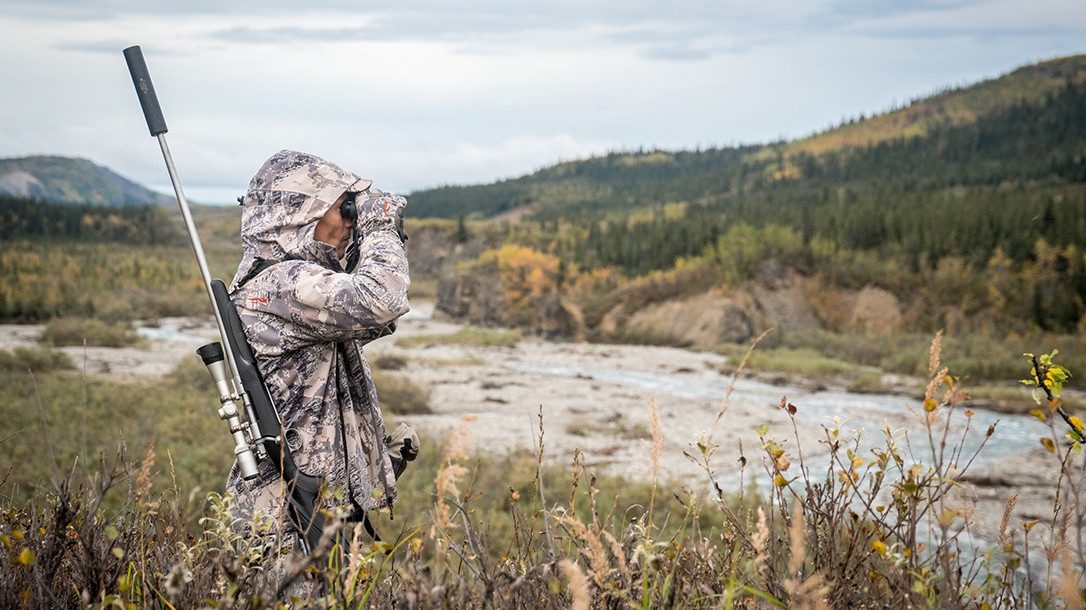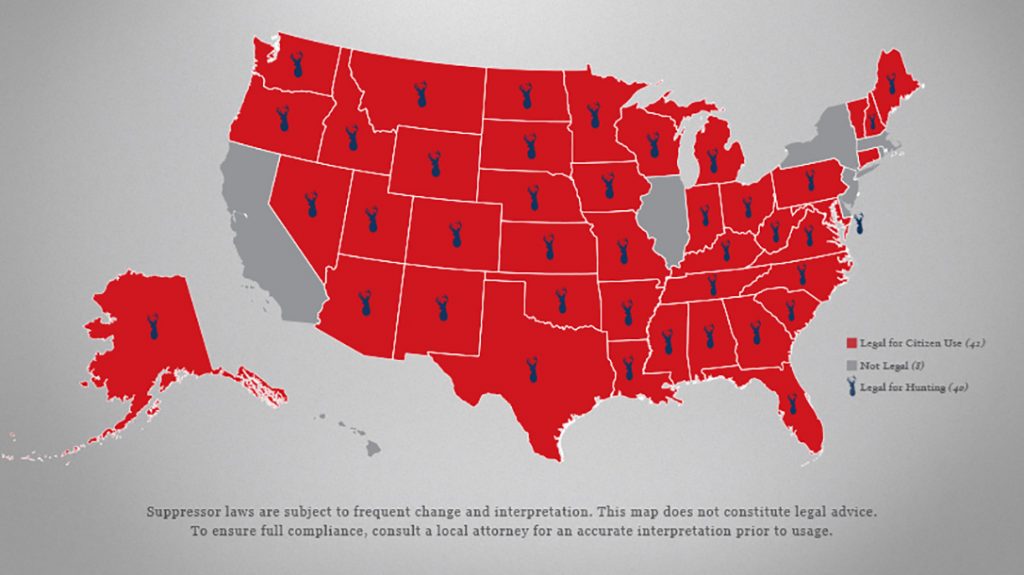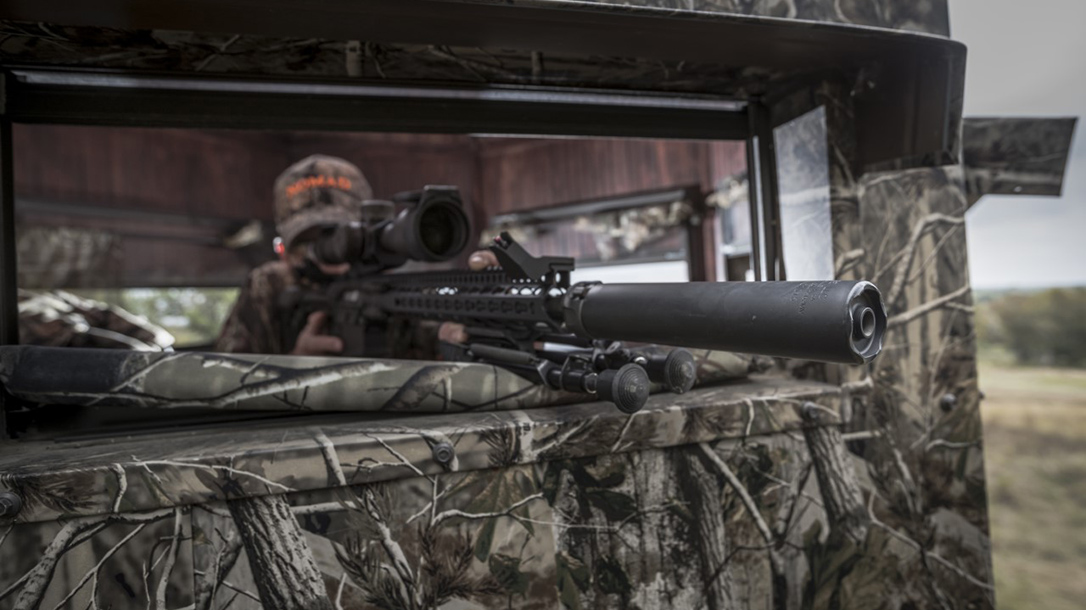It’s time to take a serious look at what firearm suppressors (also called silencers or cans) can add to your survival strategy. Sometimes your best option is to keep a low profile, which may put you out in the wilderness or constantly on the move. Either way, it’s likely that you’ll need to harvest your own food and probable that you’ll have to defend yourself. A suppressor on your rifle can help you do that more discreetly, but probably not as much as you think it will if you formed your opinions about them based on TV and movies. So what does hunting with a suppressor actually look like?
The reality is that most suppressed centerfire rifles are closer in report to an unsuppressed .22 rifle. That’s why it’s more accurate to call them suppressors rather than silencers. Still, let’s not diminish the achievement. Getting the report of a .308 rifle down to the level of a .22 rifle is a huge improvement. You’ll scare away less game and draw less attention to yourself afield hunting with a suppressor. That being said, the big gain is the protection of your hearing.
Hunting With a Suppressor
A good suppressor can reduce the loudness of gunshots from any firearm by 25 to 40 decibels, with a 30-decibel reduction being typical. Consider that the ubiquitous foam earplugs you’ve used at the range reduce sound about 29 decibels, so what guns sound like to you with earplugs in is similar to what they actually sound like suppressed. Rifle suppressors are designed to reduce the report of the firearm to below 140 decibels. 140 decibels is the point at which permanent hearing damage occurs.
Advertisement — Continue Reading Below
Between 70 and 80 percent of hunters use no hearing protection of any kind. Why? Because of their desire for situational awareness in the field. The price of that awareness when a 140-decibel shot is fired is an instant, painful ringing in the ears. It also yields progressively less hearing every time they pull the trigger. Hunters have realized the benefits of using suppressors, and they’re rapidly gaining popularity. Suppressors are now legal to own in 42 states and legal to hunt with in 40.
In addition, suppressors have been shown to often improve accuracy and reduce recoil. The extra weight on the muzzle and the gasses pushing forward against the baffles inside the suppressor are the source of the reduction in felt recoil. Gains in accuracy stem from less stressful shooting, like reduced involuntary flinching associated with a loud report, and sometimes from the suppressor’s effect on the harmonics of the individual rifle barrel. Other than adding 6 to 24 ounces to the rifle and making it impossible to use low-mounted iron sights, there are no negatives to using a suppressor for hunting.
The Build
Suppressors vary in size, weight, and durability. The military of late has favored quick-detachable, heavy, rugged, welded steel models like the SOCOM300-SPS made by Surefire. This 8-inch-long, 1.5-inch-diameter, 20.3-ounce unit is made of stainless steel and high-temperature alloy. People have been known to shoot these suppressors red-hot, though that can’t be prudent.
Advertisement — Continue Reading Below
Suppressors can be made considerably lighter by using a combination of materials and a simple screw-on attachment. The Gemtech Tracker is an example of this type. It’s one-tenth of an inch shorter than the SOCOM300-SPS. However, it weighs only 11.3 ounces due to its aluminum and titanium construction. It’s not designed to hold up under sustained rapid fire. Gemtech advises shooters to allow it to cool to ambient temperature after firing 10 rounds.
The best combo of durability and light weight is found in suppressors made entirely of titanium. One example is the Freedom Armory Dragoon 7.62 Suppressor. It’s 9.5 inches long, 1.38 inches in diameter but weighs only 12.95 ounces equipped with a quick-detachable feature. Freedom Armory recommends allowing it to cool after 60 rounds of rapid-fire through a 16-inch or longer barrel.
The Mechanics of Hunting With a Suppressor
Modern suppressors are mounted on the barrel in one of two ways. The simplest and cheapest is directly screwing it onto a threaded muzzle. Alternatively, suppressor manufacturers have invented various proprietary quick-detachable mechanisms. They require the muzzle to be fitted with a special mounting base, but this allows for suppressor installation or removal within seconds. The best-designed ones will change bullet impact minimally, about 1 inch or less at 100 yards. The mounting bases frequently incorporate a flash suppressor or muzzle brake into the design for added utility when the rifle is fired unsuppressed.
Advertisement — Continue Reading Below
The standard thread for .223-caliber suppressors is 1/2×28 threads per inch (TPI). That’s the same thread you find on the muzzle of .223-caliber AR-15s, which makes suppressor installation a do-it-yourself operation. The standard thread for .30-caliber suppressors is 5/8×24 TPI. More and more companies are offering bolt-action hunting rifles with factory-threaded muzzles. Most older rifles are unthreaded.
A screw-on suppressor is the cheaper way to go since you don’t have to spend an additional $99 to $125 for each quick-change mounting base. The quick-change feature would be helpful if you had several rifles in your survival cache to suppress. It also allows the installation of a .30-caliber suppressor onto a .223-caliber AR-15 rifle. This is something you could not do with a direct-attach model because of the difference in mounting-thread size.
All About Ammo
The caliber and type of ammo you shoot will affect suppressor performance. Though any cartridge can be suppressed, loads with subsonic velocity (below the speed of sound) are the quietest. Two examples are standard-velocity .22 LR and 300 AAC Blackout ammo.
Advertisement — Continue Reading Below
Anything supersonic (almost any centerfire rifle caliber) is going to produce its own sonic boom (crack of the rifle shot). There’s nothing a suppressor can do to change that. That’s not to say a suppressor won’t help when hunting; it absolutely will. This is because it reduces the volume of the gunshot by 25 to 40 decibels, which means that sound, at least, won’t carry as far as an unsuppressed shot. If you need to hunt with maximum stealth, there are limited power and velocity options.
Different Game

You aren’t going to be hunting elk or bear with subsonic 300 AAC Blackout. However, plenty of deer-sized game have fallen to blackpowder rounds of comparable power. Loaded with a heavy 220-grain bullet, the round is quite effective in wild pig hunting. If you’re hunkered down somewhere, you’ll want to minimize your hunting forays to reduce the chances of revealing the location of your hideout. It may make sense to hunt larger game to get the most meat from each of your precious bullets. If you’re on the move, it’s more likely that you’ll be filling your cook pot with small game you can take with .22 LR. Does this mean you need two suppressors? The good news is no, but with some specifications.
Advertisement — Continue Reading Below
The stacked (multi-piece) baffles commonly used in .30-caliber rifle suppressors will also reduce the noise of smaller calibers. Because .30-caliber suppressors are physically bigger, they’re sometimes even more effective than a suppressor made specifically for the smaller rifle caliber. If they’re worse, it’s generally only by a couple decibels. If you can buy only one suppressor, one designed for .30 caliber will be the most versatile. Here’s the caveat: The manufacturers of permanently sealed suppressors advise against shooting .22 LR ammo through them because it’s very dirty. It leaves lead and powder deposits inside that build up over time and cannot be cleaned out.
When Priorities Shift
Continuously shooting .22 LR ammo will eventually clog up and ruin your sealed suppressor, which you could easily have spent from $800 to $2,500 on before the $200 tax. In normal times, jeopardizing your investment would be foolish, but any situation that has you bugging out to stay alive isn’t normal. Desperate times call for desperate measures.
The fact is that it’s going to take a lot of .22 LR to clog up a big .30-caliber suppressor. Your days of casually plinking away a brick of 1,000 rounds for fun ended when the looters cleaned off the Walmart shelves two hours after the Emergency Alert System came on the air. Every bullet is a finite precious resource at that point. You won’t shoot even one except to put food in your belly or defend yourself. At that rate of fire, you won’t have to worry about suppressor degradation for many years. Using copper-plated bullets will help, too.
Advertisement — Continue Reading Below
While almost all .30-caliber suppressors are sealed units that can’t be serviced by the user or even the manufacturer, the aforementioned Freedom Armory Dragoon 7.62 suppressor is an exception. It’s one of the very few suppressors designed to be completely disassembled for cleaning by the user. This type of lightweight titanium suppressor would be ideal on a .22-caliber survival/hunting rifle. Because shooting .22 LR does no irreparable harm, you can practice your critical small-game marksmanship until no squirrel’s eye is safe within 25 yards.
Effective Uses
The quiet hunting efficacy of subsonic .22 LR and 300 AAC Blackout are signposts pointing the way to the ideal suppressed hunting rifle for the survivalist. With the addition of a 300 AAC Blackout barreled upper receiver and a .22 LR adapter kit, the combat-proven .223-caliber AR-15 rifle platform equipped with a quick-detachable .30-caliber suppressor is the only weapon with the versatility to use all three cartridges from the same gun.
In a fight, the reduced gunshot noise and sonic crack of the .223 are less likely to give away the marksman’s position. It is adaptable for the quietest hunting of small- and deer-sized game. For small game, convert it to .22 LR with a kit that includes a replacement bolt and magazine (CMMG makes one that’s around $220).
Advertisement — Continue Reading Below
I’ll Take One!
“OK,” you say, “I can live off deer and squirrel. I’m going to run out and buy a suppressor before the North Koreans hit us with an EMP and throw our civilization into barbarous chaos for years.”
Unfortunately, it’s not that easy. At present, suppressors are Class II weapons. The National Firearms Act (NFA) regulates them, which makes them subject to the same controls as machine guns. To legally possess one, at the very least, you’ll fill out a lot of paperwork and pay a $200 tax. Then you’ll wait eight months for the Bureau of Alcohol, Tobacco, Firearms and Explosives (BATFE) to process your approval paperwork.
The good news is that the American Suppressor Association (ASA) has made a lot of progress over the last eight years to remove suppressors from the NFA list so they can be sold like ordinary firearms.
Advertisement — Continue Reading Below
The ASA worked with Congress to write the Hearing Protection Act. It’s a bill that now has 28 co-sponsors in the Senate and 65 in the House. The ASA is hopeful that they will get the bill a hearing in committee and a vote on the floor.
You can help by going to HearingProtectionAct.com and voicing your opinion directly to those on Capitol Hill; 250,000 people already have. It might end up saving you a $200 tax on that suppressor purchase.

This article is from the summer 2020 issue of Survivor’s Edge Magazine. For more exclusive content, grab your subscription at OutdoorGroupStore.com.
























